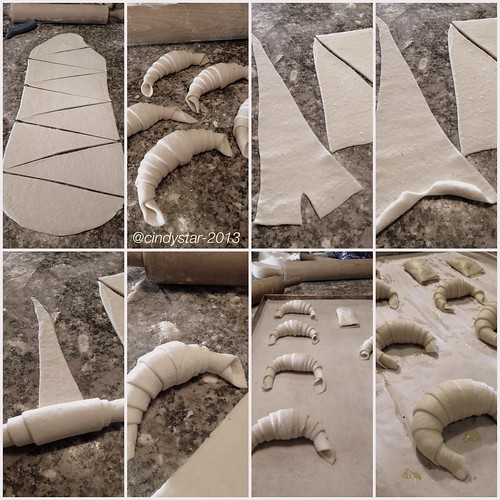Classic Croissants - We Knead To Bake # 2
la ricetta in italiano qui
Second session with We Knead To Bake, the baking group Aparna of My Diverse Kitchen created last month with the very nice idea to bake a different bread every month, 12 breads in all this year.
Recipe for this challenge is Original French Croissants, one of the most divine things you can have for breakfast! You should go any place in France and walk around any bakery early in the morning to be amused and tempted by the aroma of this delicious treat filling the air ... you can't resist! :-)
I have already made croissants before, more than once, and I am used to make puff pastry as well, so it wasn't difficult for me to deal with butter, lamination and rolling, still I've found this recipe very manageable and the dough so suitable for the work, definetely one of the best!
So thanks to Aparna for her choice (and adaptations) and to Jeffrey Hamelman’s Classic Croissants' recipe.
The recipe is very long and detailed, Aparna has been very clear and precise just to explain every single little passage, but if it's your first time please take a look at the video on croissant making, then you will feel much comfortable with it and surprisingly find yourself a real croissant maker too! :-)
The recipe is usually made in 3 days, so to have just a little work every single day (making dough in the evening the first day - lamination the second day after lunch - shaping, proofing and baking the third day after lunch, croissants ready for teatime).
But I shortened the work to 2 days: dough early in the morning - lamination the second day after dinner - shaping, proofing and baking the following day after lunch, croissants ready for teatime, or else you could shape, proof and bake in the morning to have croissants ready for a late Sunday brunch (they are so perfect with a savory filling!).
You can also make Pain au Chocolat with the same dough (I tried some with the pastry scraps) by cutting the pastry in straight long strips (little rectangles), fill with dark chocolate chips and roll up into "logs".
Any sort of filling
you decide (cream, jam, ham&cheese, other suggestions here) should be added just before you roll and shape the croissants, and don't forget to press gently the tips of the croissants to avoid filling come out.
This dough is making 14/15 croissants and a few smaller with the scraps, but if you don't want all croissants in one go you can divide the dough in 2 (after lamination and refrigeration overnight) and keep in the fridge wrapped for 2/3 more days, or else freeze (in this case, once you want to use it, just thaw overnight in the fridge, then shape/proof/bake as recipe).
Today's the day of revealing, linking our post to Aparna's, where you can find the complete list of baked breads.
Aparna's tips to have croissants come out the best:
- Ensure that your butter is cold – cold enough that it is pliable enough to smoothly roll out; not hard (or it will break) or soft (it will melt). If the butter is too hard and breaks while rolling out the dough, you will not get the layers in the croissants.
- Do not over-knead / develop the dough too much, too much gluten will not help during the lamination process. The lamination process itself is a kind of stretch and fold anyway and will strengthen the dough. So keep to the 3 minutes the recipe says. You want a soft dough, not an elastic one.
- When you cover the butter square with the dough, make sure you seal the dough well, otherwise the butter will leak out when you roll out the dough, and there’s no way you can manage to put the butter back in. You will also end up with butter leaking during the baking.
- Always, always make sure your dough and butter inside it are cold. I cannot stress the importance of this enough. Once the butter has melted, it is difficult to get the dough to produce layers because the dough tends to absorb the butter and will make greasy croissants. So, while working with the dough, or when rolling it out, if at any point you feel the dough becoming warm and soft, put it back in the fridge immediately. Also work as quickly as you can so the butter stays cold.
- During the lamination of the dough (rolling and folding repeatedly), chill the dough in the freezer and NOT the fridge. The overnight refrigeration is to be done in the fridge NOT in the freezer. Resting the dough is an important part of the croissant making process.
- Plan ahead and make sure you do all this when you have the time for it. You will need more time than you think you, believe me. You cannot leave this and attend to something else, unless you want to set yourself for failure!
- You also need a lot of patience to keep rolling out the dough with just enough pressure to stretch it. The rolled out dough before shaping should be somewhere between 1/4” and 1/8” thick.
- Make sure your dough is shaped with straight lines and square-ish corners. All the time you are rolling your dough out, keep this in mind. This way you will minimise waste of dough. More importantly, the edges where there is no butter would get folded in during lamination and affect your layers. So trim off those bits if you have any of them.
- Keep lightly flouring your work surface (not too much), just enough to keep working smoothly without tearing the dough. However, dust with a light hand or you could end up adding more flour than desirable.
- Do not be tempted to fold more than three times. A fourth fold will give you more layers, but thinner butter layers between them, and your croissants will not puff of as much as you would like them to.
- And most important, as funny as it sounds. If you like to and do wear rings on your fingers like I do, take them off while working with this dough and the dough will thank you! Rings have a habit of inadvertently tearing the dough. If the butter comes out, patching it up by dusting a little flour can help but doesn’t always work.
For the dough:
4 cups all-purpose flour, and a little more for dusting/ rolling out dough
1/2 cup plus 2 tbsp cold water
1/2 cup plus 2 tbsp cold milk (I used 2%)
1/4 cup granulated sugar
40 gm soft unsalted butter *
1 tbsp plus scant 1/2 tsp instant yeast
2 tsp salt *
For the butter layer:
250 gm cold unsalted butter *
* you could use salted butter and only 1 tsp salt
For brushing:
1/4 cup of cold milk (or 1/8 cup of cream + 1/8 cup cream) or 1 beaten egg with a little milk
Day 1 - Make the dough (and refrigerate overnight)
Combine all the ingredients for the dough in the bowl of a stand mixer fitted with the dough hook. You can also use a food processor with the plastic blade, or do this by hand.
Mix everything on low speed for 3 minutes, scraping the sides of the mixing bowl once if necessary. Then mix further on medium speed for 3 minutes. Lightly flour a 10-inch pie pan or a dinner plate. And place the ball of dough on this.
Gently shape the dough into a flat ball by pressing it down before storing it in the fridge, this makes rolling out next morning easier. Making a tight ball will strengthen the gluten which you do not need. Lightly dust the top of the dough with flour and wrap well with plastic so it doesn’t dry out. Refrigerate overnight.
Day 2 - Make the butter layer and Laminate the dough
The next day, cut out 2 pieces of parchment or waxed paper into 10” squares each. Cut the cold butter into 1/2-inch-thick slabs. Place these pieces on one piece of parchment/ waxed paper so they form a 5- to 6-inch square. Cut the butter further into pieces as required to fit the square. Top with the other piece of parchment/ waxed paper.
Using a rolling pin, pound the butter with light, even strokes. As the pieces begin to stick together, use more force. Pound the butter until it flattens out evenly into a square that’s approximately 7-1/2”. Trim the edges of the butter to make a neat square. Put the trimmings on top of the square and pound them in lightly with the rolling pin. Refrigerate this while you roll out the dough.
You can see step-by-step pictures in Aparna's post, I forgot to use my camera.
Laminate the dough
Unwrap and lay the dough on a lightly floured work surface. Roll it out to a 10-1/2-inch square, and brush off the excess flour. Take the butter out from the refrigerator —it should be cold but pliable. If it isn’t refrigerate it till it is. This so that when you roll out the dough with the butter in ti, neither should it be soft enough to melt, or hard enough to break. Unwrap the butter and place it on the square of dough in the centre, so that it forms a “diamond” shape on the dough.
Fold one flap of dough over the butter toward you, stretching it slightly so that the point just reaches the middle of the butter square. Bring the opposite flap to the middle, slightly overlapping the previous one. Similarly repeat with the other two so that the dough forms an envelope around the butter. Lightly press the edges together to completely seal the butter inside the dough to ensure the butter doesn’t escape when you roll out the dough later.
Lightly flour the top and bottom of the dough. With the rolling pin, firmly press along the dough uniformly to elongate it slightly. Now begin rolling instead of pressing, focusing on lengthening rather than widening the dough and keeping the edges straight.
Roll the dough into an 8” by 24” rectangle. If the ends lose their square shape, gently reshape the corners with your hands. Brush off the excess flour. Mark the dough lightly equally into three along the long side. Using this as a guideline, pick up one short end of the dough and fold 1/3rd of it back over the dough, so that 1/3rd of the other end of dough is exposed. Now fold the 1/3rd exposed dough over the folded side. Basically, the dough is folded like 3-fold letter before it goes into an envelope (letter fold). Put the folded dough on a floured baking sheet, cover with plastic wrap, and freeze for 15 to 20 minutes to relax and chill the dough.
Repeat the rolling and folding, this time rolling in the direction of the two open ends (from the shorter sides to lengthen the longer sides) until the dough is about 8” by 24”. Once again fold the dough in thirds, brushing off excess flour and turning under any rounded edges or short ends with exposed or smeared layers. Cover once again with plastic wrap and freeze for another 15 to 20 minutes.
Roll and fold the dough exactly in the same way for the third time and put it baking sheet. Cover with plastic wrap, tucking the plastic under all four sides and refrigerate overnight.
Day 3 - Divide the dough - Shape, proof & bake the croissants
The next day, unwrap and lightly flour the top and bottom of the dough. Cut the dough along the longer side into halves. Cover one half with plastic wrap and refrigerate it while working on the other half.
“Wake up the dough up” by pressing firmly along its length with the rolling pin. Don’t widen the dough but simply begin to lengthen it with these first strokes. Slowly roll the dough into a long and narrow strip, approximately 8” by 22”. If the dough sticks as you roll, sprinkle with flour.
Once the dough is about half to two-thirds of its final length, it may start to resist rolling and even shrink back. If this happens, fold the dough in thirds, cover, and refrigerate for about 10 minutes; then unfold the dough and finish rolling.
Lift the dough an inch or so off the table at its midpoint and allow it to shrink from both sides and prevent the dough from shrinking when it’s cut. Check that there’s enough excess dough on either end so that when you trim the edges to straighten them, you have a strip of dough that is 20’ inches long. Now trim the edges so they’re straight.
If you’re good at “eyeballing” and cutting the dough into triangles, then forget the measuring rule, marking and cutting instructions. Otherwise, lay a measuring rule or tape measure lengthwise along the top length of the dough. With a knife, mark the top of the dough at 5-inch intervals along the length (there will be 3 marks in all). Now place the rule or tape measure along the bottom length of the dough. Make a mark 2-1/2 inches in from the end of the dough. Make marks at 5-inch intervals from this point all along the bottom of the dough. You’ll have 4 marks that fall halfway between the marks at the top.
Make diagonal cuts by positioning the yardstick at the top corner and the first bottom mark. Use a pizza wheel/ pie wheel or a bench scraper and cut the dough along this line which connects each top mark to the next bottom mark and then back to the next top mark and so on. This way you will have 7 triangles and a scrap of dough at each end.
Shape the croissants
Now work with one piece of triangular dough at a time. Using your rolling pin, very lightly roll (do not make it thin but only stretch it slightly) the triangle to stretch it a little, until it is about 10” long. This will give your croissants height and layers. You can stretch it by hand too, but if you don’t have the practise, your stretching could be uneven.
Using a sharp small knife, make a 1/2- to 3/4-inch-long notch in the centre of the short side of each triangle. The notch helps the rolled croissant curl into a crescent.
Place the triangle on the work surface with the notched side closest to you. With one hand on each side of the notch, begin to roll the dough away from you, towards the pointed end.
Flare your hands outward as you roll so that the notched “legs” become longer. Roll the triangle tight enough but not too tight to compress it, until you reach the “pointy” end which should be under the croissant.
Now bend the two legs towards you to form a tight crescent shape and gently press the tips of the legs together (they’ll come apart while proofing but keep their crescent shape).
Shape all the triangles like this into croissants and place them on a greased or parchment lined baking sheet leaving as much space between them as they will rise quite a bit.
Proof the croissants
Brush the croissants with milk (or a mix of milk and cream). If you use eggs, make an egg wash by whisking one egg with 1 tsp water in a small bowl until very smooth. Lightly brush this on each croissant.
Refrigerate the remaining milk/ milk+cream (or egg wash) for brushing the croissants again later. Place the croissants in a cool and draft-free place (the butter should not melt) for proofing/ rising for about 1 1/2 to 2 hours. They might need longer than 2 hours to proof, maybe as much as 3 hours, so make sure to let croissants take the time to proof. The croissants will be distinctly larger but not doubled in size. They’re ready if you can see the layers of dough from the side, and if you lightly shake the sheets, the croissants will wiggle.
Bake the croissants
Just before the croissants are fully proofed, pre-heat your oven to 200C (400F) in a convection oven or 220C (425F) in a regular oven. Brush the croissants with milk/ milk+cream (or egg wash) a second time, and place your baking sheets on the top and lower thirds of your oven (if regular) or bake one tray at a time in the convection oven.
Bake them for about 15 to 20 minutes till they’re done and golden brown on top and just beginning to brown at the sides. In a regular oven, remember to turn your baking sheets halfway through. If they seem to be darkening too quickly during baking, lower the oven temperature by 10C (25F). Cool the croissants on the baking sheets on racks. Serve warm.
You can warm up left croissants a few minutes in the oven the next day, or else you can freeze them once baked and cooled, then reheated in the oven (Lynne suggests to read this discussion about freezing croissants).
This recipe also goes to Susan's weekly YeastSpotting




















11 commenti:
Wow love the Croissants and the post. Great job :)
I just loved your croissants!!
These croissants are just perfect!!
Thank you :-)
Wow...Beautiful bake and clicks..They look so perfect..
Can there be anything more delightful to watch than your stack of croissants. Loved baking them with you all.
Thank you, dear, really enjoyed to make them, a big hurrah for WKTB! :-)
These look heavenly- with just the perfect hue and shape.
Thanks, Anshj :-)
Beautifully done. They look awesome and your experience in baking croissants are so evident. Awesome!
Thank you so much, Jayanthi :-)
It's quite a relaxing work in a way :-)
Posta un commento
grazie della visita e gentilmente firma sempre i tuoi commenti!
thanks for passing by and please sign up your comments!